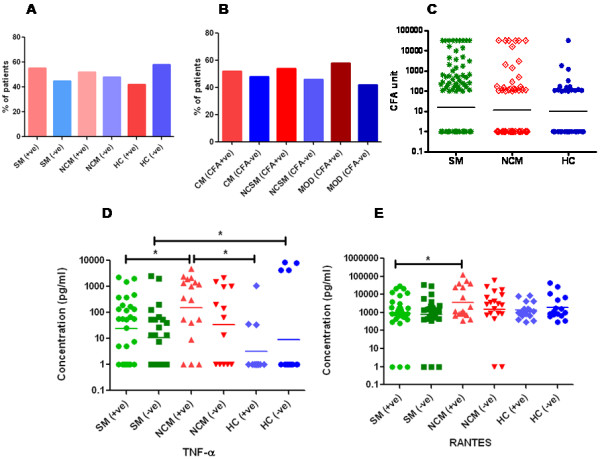Figure 1.
Prevalence of circulating filarial antigen, Levels of CFA and levels of plasma cytokines in malaria patients. Number of severe malaria, non-complicated malaria and healthy control individuals with and without active filarial infection is shown. The sample numbers are SM (CFA+ve= 69, CFA-ve=56), NCM (CFA+ve=37, CFA-ve=34) and HC (CFA+ve=16, CFA-ve=22). Fisher’s-exact test was employed to compare percentages between groups (A). Number of cerebral malaria, non-complicated severe malaria and individuals with multiorgan dysfunction with and without active filarial infection is shown. The sample numbers are CM (CFA+ve= 25, CFA-ve=23), NCSM (CFA+ve=7, CFA-ve=6) and MOD (CFA+ve=37, CFA-ve=27). Fisher’s-exact test was employed to compare percentages between groups (B). Circulating filarial antigen levels are comparable in SM (n=125, stars), NCM (n=71, squares) and HC (n=38, circles) cases (C). Association within groups was analysed by one way analysis of variance (ANOVA) followed by Tukey’s post test. Serum levels of TNF- a (D) and RANTES (E) in CFA +ve and CFA-ve were comparable in severe malaria, non-complicated malaria and healthy control individuals. Sample numbers for TNF-a: SM (CFA+ve=30, CFA-ve=25), NCM (CFA+ve=17, CFA-ve=13) and healthy controls (CFA+ve=12, CFA-ve=16). Sample numbers for RANTES: SM (CFA+ve=32, CFA-ve=26), NCM (CFA+ve=17, CFA-ve=18) and healthy controls (CFA+ve=15, CFA-ve=15). P values were determined by unpaired student’s t-test.

